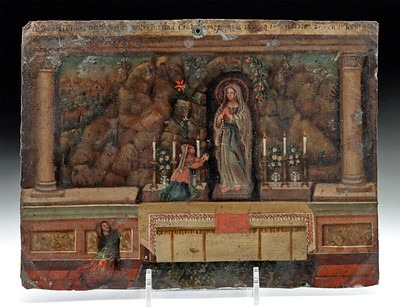Tall Ancient Japanese Jomon Pottery Jar, TL Tested
Lot 79
About Seller
Artemis Fine Arts
686 S Taylor Ave, Ste 106
Louisville, CO 80027
United States
Selling antiquities, ancient and ethnographic art online since 1993, Artemis Gallery specializes in Classical Antiquities (Egyptian, Greek, Roman, Near Eastern), Asian, Pre-Columbian, African / Tribal / Oceanographic art. Our extensive inventory includes pottery, stone, metal, wood, glass and textil...Read more
Categories
Estimate:
$8,000 - $12,000
Absentee vs Live bid
Two ways to bid:
- Leave a max absentee bid and the platform will bid on your behalf up to your maximum bid during the live auction.
- Bid live during the auction and your bids will be submitted real-time to the auctioneer.
Bid Increments
| Price | Bid Increment |
|---|---|
| $0 | $25 |
| $300 | $50 |
| $1,000 | $100 |
| $2,000 | $250 |
| $5,000 | $500 |
| $10,000 | $1,000 |
| $20,000 | $2,500 |
| $50,000 | $5,000 |
| $100,000 | $10,000 |
| $200,000 | $20,000 |
About Auction
By Artemis Fine Arts
Jun 15, 2023
Set Reminder
2023-06-15 10:00:00
2023-06-15 10:00:00
America/New_York
Bidsquare
Bidsquare : VARIETY Ancient, Ethno, Native American, Fine Art
https://www.bidsquare.com/auctions/artemis-gallery/variety-ancient-ethno-native-american-fine-art-12990
Antiquities, ethnographic, native american and fine art from cultures encompassing the globe. Artemis Fine Arts info@artemisfinearts.com
Antiquities, ethnographic, native american and fine art from cultures encompassing the globe. Artemis Fine Arts info@artemisfinearts.com
- Lot Description
East Asia, Japan, Middle to Late Jomon Period, ca. 2000 BCE. A sizable and deep hand-built terracotta vessel with an applied and corrugated pattern made by pressing a cord onto the wet clay before firing; hence the term "jomon" which translates to "cord pattern." The ancient Japanese Jomon Period is known for its distinctive pottery tradition that set it apart from the Paleolithic Age. Jomon pottery vessels are among the oldest in the world and typically present rope- or cord-like impressed decoration like the one here. Since no kilns have been excavated from the Jomon period, it is believed that the ancients fired these vessels in open fires. Size: 16.5" Diameter x 25" H (41.9 cm x 63.5 cm)
According to the Metropolitan Museum of Art's Heilbrunn Timeline essay, "All Jomon pots were made by hand, without the aid of a wheel, the potter building up the vessel from the bottom with coil upon coil of soft clay. As in all other Neolithic cultures, women produced these early potteries. The clay was mixed with a variety of adhesive materials, including mica, lead, fibers, and crushed shells. After the vessel was formed, tools were employed to smooth both the outer and interior surfaces. When completely dry, it was fired in an outdoor bonfire at a temperature of no more than about 900° C."
This piece has been tested using thermoluminescence (TL) analysis and has been found to be ancient and of the period stated. A full printed and bound report is available to the buyer upon request.
Provenance: private Illinois, USA collection
All items legal to buy/sell under U.S. Statute covering cultural patrimony Code 2600, CHAPTER 14, and are guaranteed to be as described or your money back.
A Certificate of Authenticity will accompany all winning bids.
We ship worldwide and handle all shipping in-house for your convenience.
#174559Repaired and restored from many pieces. Infill to missing pieces, gaps, and along break lines. Break lines are nearly indiscernible on exterior. Losses and chips to rim tabs and applied appliques. TL drill holes on rim exterior and on side of body.Condition
- Shipping Info
-
All shipping is handled in-house for your convenience. Your invoice from Artemis Gallery will include shipping calculation instructions. If in doubt, please inquire BEFORE bidding for estimated shipping costs for individual items.
-
- Buyer's Premium



 EUR
EUR CAD
CAD AUD
AUD GBP
GBP MXN
MXN HKD
HKD CNY
CNY MYR
MYR SEK
SEK SGD
SGD CHF
CHF THB
THB














